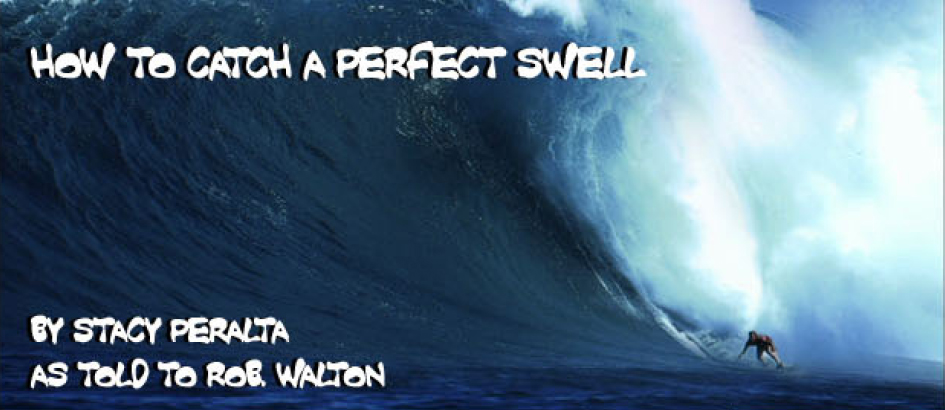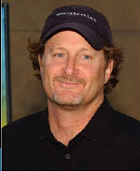
 In 1975, fearless California surf punk/skater Stacy Peralta became the father of modern skateboarding when he and his team of Z-Boys introduced the extreme style of the sport. Peralta became skateboarding’s first breakout star at the time when Vans picked him up for a lucrative sponsorship deal. In turn, he later sponsored Tony Hawk for 11 years. Since those glory days Peralta has turned his attention to making movies when he’s not shredding water or asphalt. His 2001 surf-skate documentary Dogtown and Z-Boys is the definitive first-person history of the early days of the sport. Riding Giants, currently in theaters, chronicles the origins of modern surfing in Hawaii in the 1950s through the extreme form of giant wave tow-in surfing today. In this interview, Peralta imparts his wisdom of the waves to advise beginners on how to catch the perfect swell.
In 1975, fearless California surf punk/skater Stacy Peralta became the father of modern skateboarding when he and his team of Z-Boys introduced the extreme style of the sport. Peralta became skateboarding’s first breakout star at the time when Vans picked him up for a lucrative sponsorship deal. In turn, he later sponsored Tony Hawk for 11 years. Since those glory days Peralta has turned his attention to making movies when he’s not shredding water or asphalt. His 2001 surf-skate documentary Dogtown and Z-Boys is the definitive first-person history of the early days of the sport. Riding Giants, currently in theaters, chronicles the origins of modern surfing in Hawaii in the 1950s through the extreme form of giant wave tow-in surfing today. In this interview, Peralta imparts his wisdom of the waves to advise beginners on how to catch the perfect swell.
![]()
A beginner wants to choose a modern longboard — a nine-foot board. It’s very light, it has three fins, it floats you well, it gets on the wave quickly and there’s plenty of room to stand on it. You don’t want to learn on a small board.
![]()
Before you get in the water, you need to learn one of the most important things about surfing: jumping up in one smooth motion. From lying in a push-up position on your front, you jump up in one motion and land on both feet at a side angle from where you started. Most people, when they learn to surf, will be running down the wave and they’ll get up on one foot then get up on the other foot. During the time of that crawl they’ll be dropping down the wave and they’re going to fall. The whole crawl thing makes you fall. Practice on the ground jumping to your feet sideways. Practicing that on the ground will circumvent a lot of frustration.
![]()
Typically you want a sand bottom rather than a rock bottom. Typically a beach break rather than a point break, and something that doesn’t break too harshly. You don’t want to have a bad experience your first time.
![]()
Storms that are very, very far away and very powerful generate tremendous turbulence in the sea, and the distance from that storm to your beach is important because over the distance of the ocean the swells clean up. They sculpt into shape. You also want a nice offshore wind, which sculpts the surface of the ocean. It builds this beautiful little ripple into the water and gives your board a little extra grip. If it blows inland, it’s no good. It’s called blowing the waves out. You can’t surf because it makes the waves crumbly.
![]()
As you sit there in the water, you spend all your time looking out. You’re looking very long into the distance, because you’re looking for the black shadows. The waves come in black shadows. You can see the tips. After a while, there’s a certain physical intelligence that comes with surfing that we call “reading water.” You’re looking to see where the wave is going to break and how it is going to break. So you are anticipating something that is going to happen down the line.
![]()
A big wave goes about 20 miles an hour, so you have to paddle your board 20 miles an hour to catch it. If a wave’s traveling that speed, you have to be in front of it and paddling so that when it finally gets you, you’re going as fast as it is, and then you have to push yourself down the face. You’ve got to hustle. You’ve got to dig your hands in and just shove yourself. A lot of beginners will feel the lift of the wave and think, “I’m in!” and they’ll stop paddling. The wave will just go by them. If you don’t push down, the wave will pick you up and throw you down with it. So you’re matching and surpassing its speed to get down and get a running start.
![]()
As soon as the wave gets under you, you start feeling that the board is no longer moving because of your power. If you try to jump up right then, the wave will push you down. The scary thing is to really “catch the wave.” When it picks you up, you have to push it down. Push the nose down. You need to jump up when the board is starting to go down almost vertically and you’re looking down over the ledge. Beginners usually panic and they usually bail the board. They’re just not used to it. They think they’re going to fall and so they do fall. Once you realize that’s how to do it, you learn how to get up on that angle and on that ledge and drop down. It’s about learning how to judge the wave and anticipate what it’s going to do.